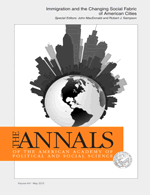Main navigation
 The latest issue of the Annals of the American Academy of Political and Social Science features new immigration research from former RSF Visiting Scholars Robert J. Sampson and Jamie Winders. Sampson co-edited the journal issue, which examines immigration and the changing fabric of American cities. In the introduction to the issue, Sampson explains the themes of the collected research:
The latest issue of the Annals of the American Academy of Political and Social Science features new immigration research from former RSF Visiting Scholars Robert J. Sampson and Jamie Winders. Sampson co-edited the journal issue, which examines immigration and the changing fabric of American cities. In the introduction to the issue, Sampson explains the themes of the collected research:
[We wanted] to bring together a leading set of scholars to present new research on trends in the spatial forms of immigration that are transforming the American landscape—the effects of "the world in a city," as it were. We aimed for a distinctive analytic focus—as a whole the volume is characterized by a comparative approach, an examination of recent immigration trends, disaggregation by ethnicity or immigrant type wherever possible, a focus on core features of the nation's social fabric...and empirical study going beyond the big cities of traditional concern to a host of smaller cities and towns reaching into far-flung pockets of the country.
The journal also includes an article from Jamie Winders, a geography professor at Syracuse University. Entitled "Seeing Immigrants: Institutional Visibility and Immigration Incorporation in New Immigrant Destinations," the article continues the research Winders conducted as a RSF Visiting Scholar in 2010-2011. Here is the abstract:
Since the 1990s, immigrant settlement has expanded beyond gateway cities and transformed the social fabric of a growing number of American cities. In the process, it has raised new questions for urban and migration scholars. This article argues that immigration to new destinations provides an opportunity to sharpen understandings of the relationship between immigration and the urban by exploring it under new conditions. Through a discussion of immigrant settlement in Nashville, Tennessee, it identifies an overlooked precursor to immigrant incorporation—how cities see, or do not see, immigrants within the structure of local government. If immigrants are not institutionally visible to government or nongovernmental organizations, immigrant abilities to make claims to or on the city as urban residents are diminished. Through the combination of trends toward neighborhood-based urban governance and neoliberal streamlining across American cities, immigrants can become institutionally hard to find and, thus, plan for in the city.
Read the journal issue (subscription required), or more information on RSF's immigration program.





